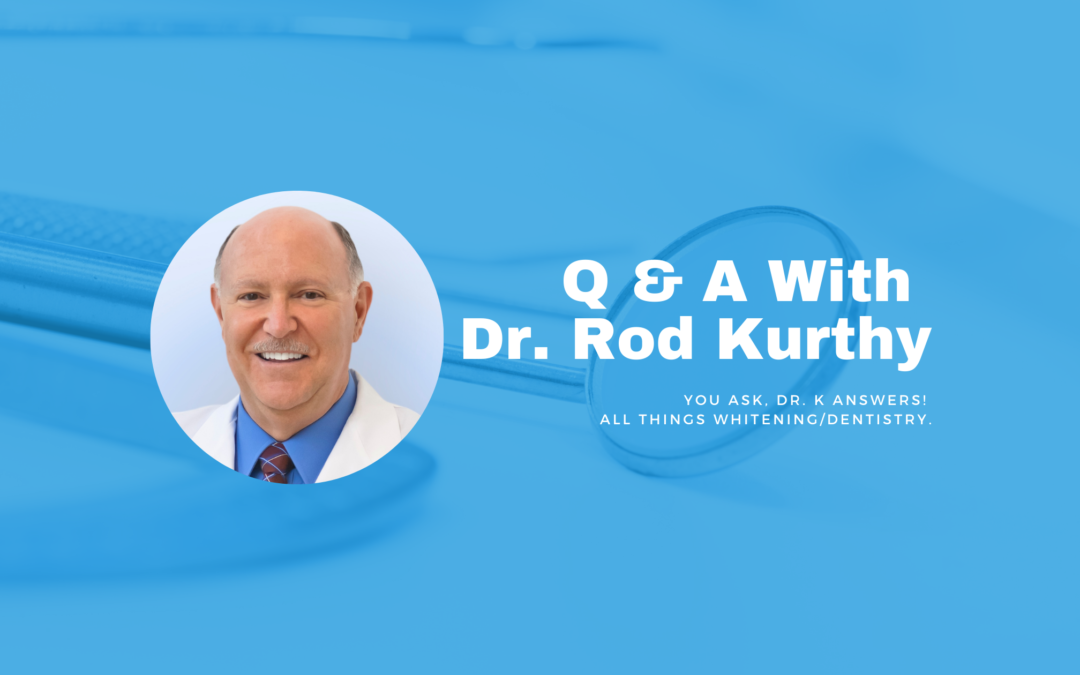Today’s question comes to us from South African hygienist Karen Jordaan. It’s the second such question we’ve received in the last week. Karen asked, “Good Day Dr. Kurthy. What is your take on the whitening of teeth before restoration of enamel caries?”
There is not a truly straightforward answer due to the wide variety of carious teeth. The fact that, to my knowledge, there is no published, scientifically proven answer doesn’t make it easier. Answering this question will require that I offer my personal opinion, supported by science, logic, and experience. My opinion is also influenced by the virtual 100% lack of complaints or notification by the many thousands of KöR Whitening dentist customers worldwide regarding any problems encountered by whitening prior to restorative dentistry to treat caries.
In fact, in the training KöR Whitening dentists receive, I specifically state my opinion, which I will lay out below, so I would assume with thousands of KöR Whitening dentists having treated patients prior to caries removal, if they had experienced problems, we most certainly would have heard about it…and we’ve heard nothing but crickets regarding this topic.
Within reason, I recommend whitening prior to restorative treatment.
If you were to restore teeth prior to teeth whitening, what shade would you select? There is no way to know what shade a patient will achieve before the whitening is performed. So, when you select a shade to restore the caries, and that shade doesn’t match after you then perform whitening… how do you think your patient will like that? When those new restorations, placed before whitening, do not adequately match the shade after whitening, who’s going to pay to replace the newly placed restorations with the properly matching shade?
Or you could stick your patient with a needle, deliver anesthetic, drill on their teeth to remove the caries and place a temporary filling prior to whitening. And then, after whitening, put the patient through that all over again. Also, peroxide bleaching factors are sneaky little devils – they can get under just about anything. So, what type of temporary restoration will you use that would seal out the bleaching factors? Most temporary restorations don’t truly seal all that well. And we know that trauma to the pulp is cumulative, so this would traumatize the tooth/teeth twice.
Also, think about your own practice. How many patients with caries complain about sensitivity? Very few. Most have no idea they have caries until you tell them and show them on radiographs and photos. The fact is that carious tooth structure is a pretty darned good thermal insulator.
And how long does it take to whiten teeth? Certainly not long enough to worry about the caries getting significantly deeper. And let’s talk about the probability of caries getting deeper (or not) during whitening. Let’s talk about what scientific research has taught us about peroxide and caries…
Carbamide peroxide in custom-fitted trays has been used successfully to reduce caries for a long, long time.
Carbamide peroxide kills one of the types of bacteria that cause caries (lactobacillus), elevates the oral pH within the first five minutes of application, and keeps the pH elevated throughout the wearing time of the trays. And of course, we all know how crucial an elevated pH is to preventing the formation and progression of caries.
Even scientific reports from well over a hundred years ago reference the use of carbamide peroxide on young patients with pitted teeth to reduce pit and fissure caries.
As a dentist, I want (on behalf of my patients’ desires) to achieve the overall tooth shade change that will make my patient turn cartwheels and have time for that new shade to stabilize. And THEN provide cosmetic and restorative treatment to make those new restorations virtually invisible by matching the shade and translucency perfectly. And I see absolutely no reason not to.
However…
Don’t you hate the fact that there always seems to be a “however”? Of course, there are other potential extenuating circumstances. Let me see if I can think of a couple…
Loose restorations. When restorations are loose/leaky, you can bet that your whitening gel will seep under those restorations, and some of it will stay there for hours. This can potentially lead to more whitening sensitivity. And we can’t even apply the KöR Complete desensitizer under those loose, leaky restorations as we do to the external surfaces of the teeth to reduce and prevent whitening sensitivity. This may be a good situation to remove caries before whitening.
Or, if there are areas with truly deep caries, where there may be some resultant acute or chronic pulpal inflammation, I may be concerned that any whitening sensitivity might compound that pulpal inflammation and result in a painful acute episode of pulpitis. This, too, may be a reason to eradicate the caries in some manner before whitening.
And I’m probably forgetting another one or two “howevers.” But all in all, I’ve not found, either through my own experiences, from the scientific literature or the many thousands of KöR Whitening dentists out there, that it is necessary or even advisable to eradicate all caries prior to teeth whitening – other than in cases of what I refer to as “fires” that need immediate attention.
Yet, with all of this evidence, I see and hear many dentists stating that it is required to remove all caries prior to whitening. I don’t know where they get that from or if they are simply making that assumption. But I’m afraid I have to disagree.
That’s my opinion…and I’m sticking to it! 😊
Very best regards,

Dr. Rod Kurthy


